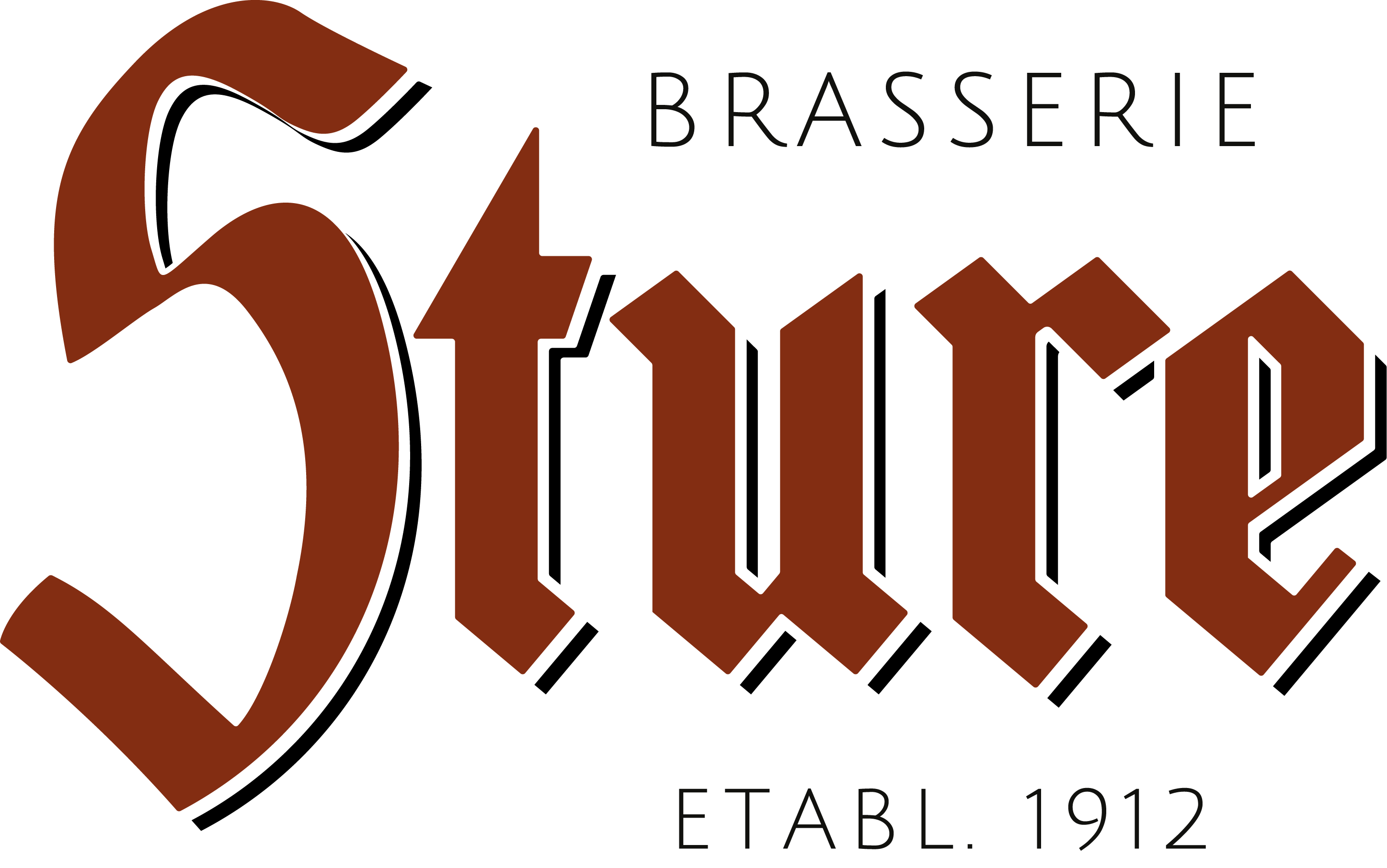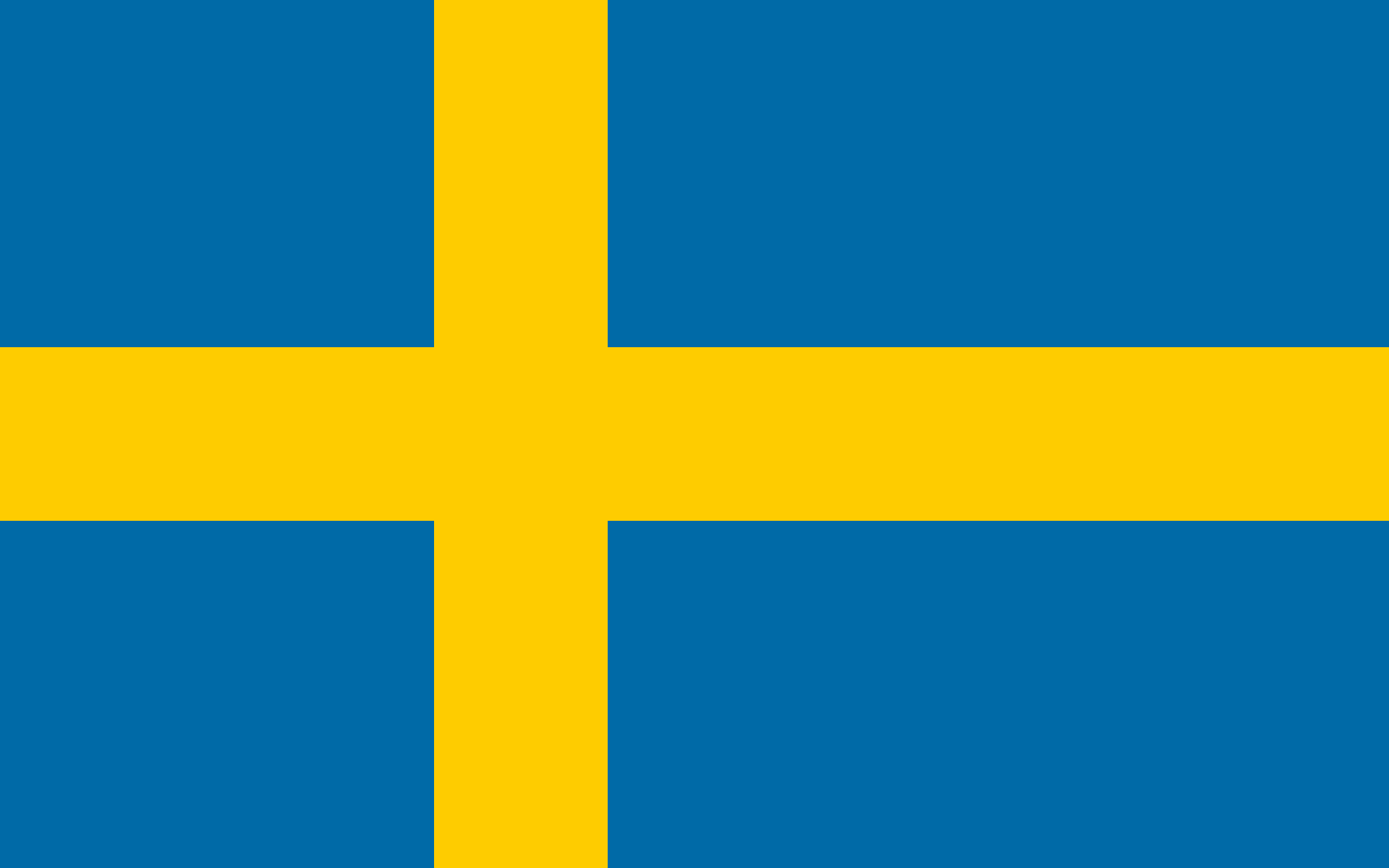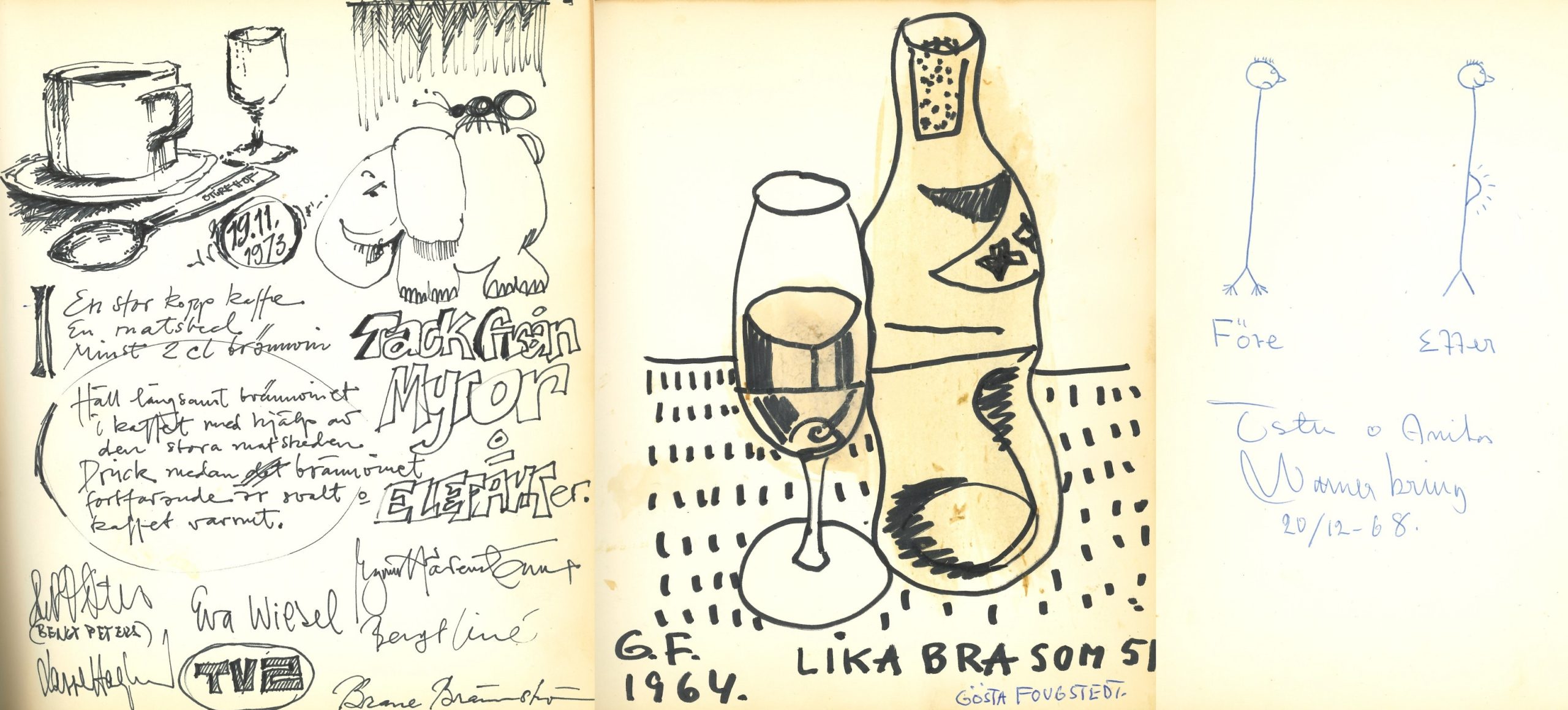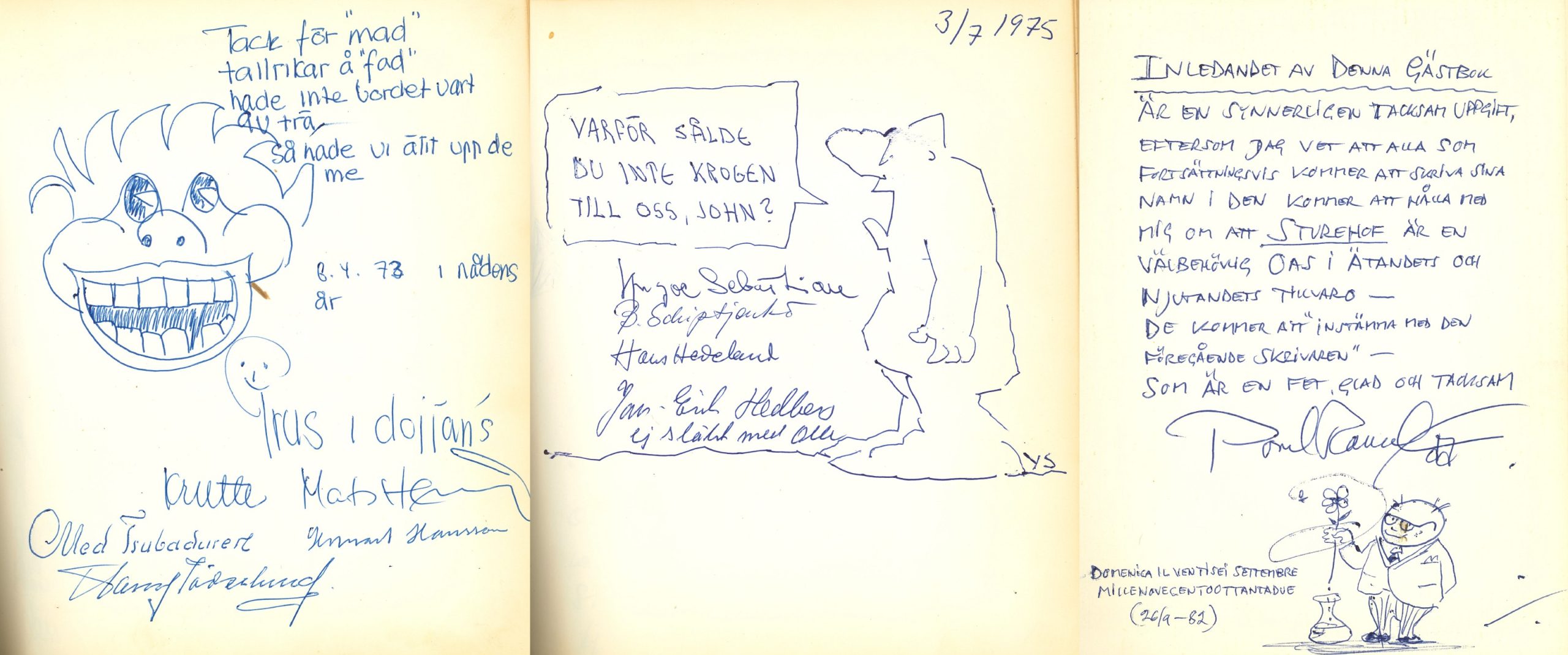THE HISTORY OF STURE


One of the first known photographs of Sturehof on Adelgatan. Probably from the 1910s-1920s.
Image: Malmö Museum
STUREHOF OPENS ITS DOORS
The foundation of what now is Brasserie Sture 1912 was Café & Restaurant Sturehof, which opened in 1912 in Hultmanska huset at Södergatan 20. The man who founded this establishment was Carl Wilhelm Hallkvist. In 1913, Nils Jönsson became the manager of the restaurant. Mr. Jönsson had previously worked at both Stadt Hamburg and Kramer, then after went to gain experience in Germany, England, France, and America. In 1915, the business moved to Adelgatan 13, where the restaurant is still located. The building that Sturehof moved into was owned by Viktor Emanuel Montgomery and was designed by architect Alfred Arwidius in 1897. The space where the restaurant is situated was originally intended for shops, but just before Sturehof moved in, there was a plan to house Hotel Savoy’s silent film theatre.


1913-14. Södergatan with number 20 and Sturehof on the right. Image: Gleerups (Bilder i Syd)
After World War I, the restaurant flourished. Sture was and still is located near the central train station, and Adelgatan was Malmö’s main street for a large part of the 20th century. Adjacent banks, accounting and law offices also contributed to the diverse clientele, including cultural workers, lawyers, businesspeople, families and travellers.
Nils Jönsson and his wife Anna Sofia had a son named Sture, who took over the management of the business at the young age of 23 in 1927 after his father Nils passed away.


Sturehof in the early 1930s. Likely owner Sture Jönsson behind the counter.
Image: Frans Weyer
CHANGE OF OWNERSHIP
In the early 1940s, Sture Jönsson handed over the business to Sven Pettersson. However, Pettersson only operated the restaurant for a short time, as in 1944, during World War II, John Olofsson, along with his wife Turid, took over and would go on to run the establishment for over thirty years.


John Olofsson in 1949
Image: Sydsvenskan (Bilder i Syd)
Olofsson chose to renovate what was likely a worn-down establishment in 1953. The walls were adorned with Sapele mahogany panels and plastic wallpaper above, along with a light fixture. In 1953, the establishment also got new toilets and a telephone booth outside. Certainly something that late-working journalists found useful.


Sturehof after the Olofsson couple’s renovation in 1953.
Image: Sydsvenskan (Bilder i Syd)


The opening day when Sture reopens in 1975. Maj-Britt Hansson serves the Nordgren family, Gun and Lennart, along with their son Mikael.
Image: Lisbeth Westerlund, Sydsvenskan (Bilder i Syd)
THE BANKRUPTCIES
In 1975, the Olofsson couple retired, and the restaurant was taken over by Lennart Hedberg. Lennart was the son of restaurateur Olle Hedberg, who ran both Erikslust and Strandpaviljongen. The new owner continued with the same concept, and the staff remained.
Shortly thereafter, much to the dismay of regulars, slot machines were placed in the restaurant, and it didn’t take long before it went bankrupt. In September 1976, a violent gas explosion occurred at Sturehof, and three months later, the restaurant faced another bankruptcy. The one who took over after Hedberg was Lars Malmberg, whose ambition was to restore the restaurant to its former glory, while also making it a seafood restaurant. Long-serving employees Siw Olsson, Maj-Britt Hansson, and Anna-Lisa Andersson were reinstated.
A year later, Tomas Folestam began leasing the restaurant. He also continued in the classic tradition with dishes like brisket, hash, and meatballs, but the focus shifted more towards seafood dishes. Under Folestam, Sturehof became a slightly more upscale establishment.
After Folestam’s passing in 1984, Savoy purchased the property and leased the space to three female restaurateurs, Gun Widenberg and Vivel and Elisabeth Nyberg. They ran the restaurant until it went bankrupt again in 1986.
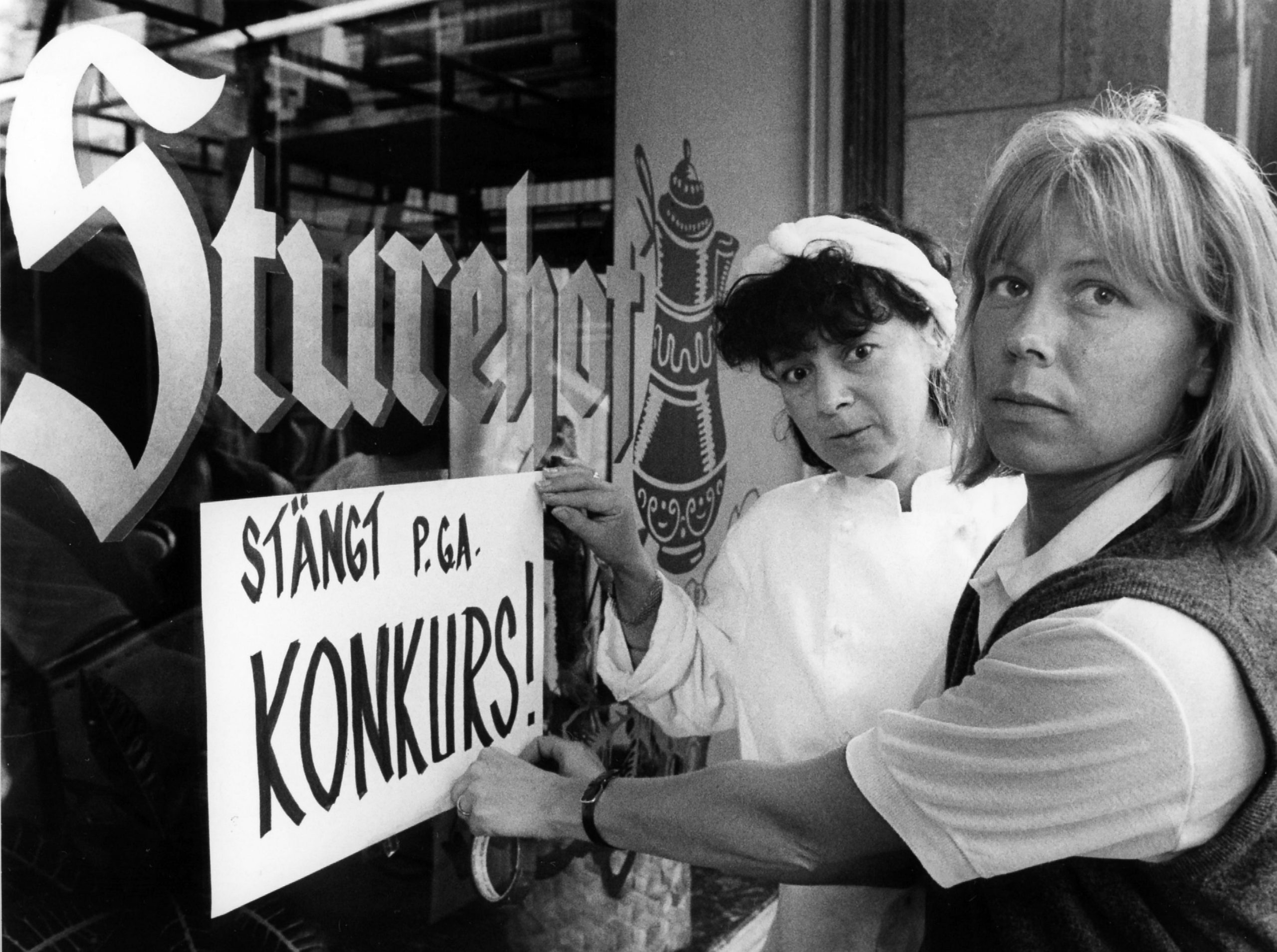

In 1986, restaurateurs Margaretha Sunesson and Gun Widerberg are forced to close. It is believed that scaffolding from Savoy’s renovation has prevented customers from finding their way in.
Image: Bosse Nilsson, Sydsvenskan (Bilder i Syd)
Taking over this time was Rutger Ahlefeldt, who had previously run the successful Pauli restaurant. Two notable chefs during Mr. Ahlefeldt’s tenure were Anders Hylin and Leif Mannerström. The focus continued to be on traditional Swedish fare, and the quality of the food may have been higher than ever before. In 1991, Anders Hylin took over and ran Sturehof for 15 years. In 2006, Anders Vendel took over the restaurant, running it under the name Vendel af Sturehof for four years before later changing the name to just Sture. This arrangement continued until 2016.
Excerpts from the guestbook during the 1960s and 1970s. From the upper left corner: Fem myror och fyra elefanter, Gösta Fougstedt, Östen & Annika Warnerbring, Grus i Dojjan, Yngve Sten and Povel Ramel
STURE RECEIVES A MICHELIN STAR
The interior of the restaurant, with its mahogany panels, had remained largely unchanged since 1953, but when Ove Linde and Hans Fribergh bought the restaurant and hired Michelin chef Karim Khouani, the interior underwent a radical transformation. With Khouani, Sture quickly gained a Michelin star. However, he left in 2018, allowing Jonas Dellow to take over the kitchen. In 2019, Sture lost its star, and a year later, during the COVID-19 pandemic, the decision was made to close the restaurant once again.
BRASSERIE STURE 1912
In early 2021, Kenneth Andrén, architect Jonas Lindvall, and experienced restaurateur David Kallós took over. The latter is known not least from the legendary Malmö restaurant Brogatan. The trio believes in the importance of traditions. Therefore, the restaurant underwent a renovation under the office of Lindvall’s guidance, with great respect for its history. Similarly, our selection of food and drinks is contemporary but deeply rooted in European restaurant culture. In the true spirit of Skåne, we serve well-prepared, affordable food that satisfies and brings joy.
Visiting Sture 1912 should be easy. We’re open seven days a week, from lunch to midnight. You can drop in before or after the theatre, for a lunch meeting, or for a drink with some snacks at the bar. It’s also an excellent place to celebrate special occasions, whether alone, as a couple, or in a large group.
In short.
We wish you a warm welcome!


Today’s restaurant opened in 2021.
Image: Tine Guth Linse
